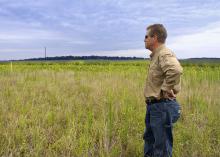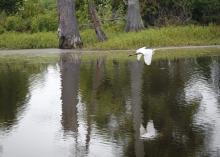Information Possibly Outdated
The information presented on this page was originally released on August 11, 2014. It may not be outdated, but please search our site for more current information. If you plan to quote or reference this information in a publication, please check with the Extension specialist or author before proceeding.
Delta plantation succeeds with conservation efforts
MISSISSIPPI STATE -- Conservation land management practices have made the Pleasant Lake Plantation in Leflore County a model of sustainability and functionality.
Pleasant Lake has about 1,700 acres near Greenwood. The plantation includes about 500 acres in row crop production, 600 acres in timber, 110 acres in Conservation Reserve Program grassland, along with a 50-acre lake and lowlands that are prone to flooding.
Guy Ray, president of the company, has taken many steps to make the property beautiful, useful and sustainable. The property is a prime example of the type of synergy between agriculture and natural resources advocated by REACH, the Research and Education to Advance Conservation and Habitat program. REACH is housed at Mississippi State University and is an effort to scientifically support and raise awareness of innovative conservation practices throughout the state.
The row-crop farmland was one of the first concerns Ray addressed.
“We are 100 percent furrow-irrigated, and several years ago, we installed drop pipes to control erosion caused by water runoff,” Ray said. “Two years ago, we finished the last land-forming on the farm, and we are a minimum-tillage operation.”
Extra tillage practices are used every other year to control weeds, but the farm mostly uses chemical weed control.
The entire farm is enrolled in a conservation program offered through the Farm Service Agency that requires Ray to keep records on a variety of management practices, such as woodland burns for fire control, and oil and polypipe recycling.
“We document all the activities. I think we were the first in Leflore County to sign up for the program,” Ray said.
Three years ago, MSU forestry students under the direction of their professor developed an overall forestry plan for the timberland.
“We implemented a conservation timber harvest on our 600 acres of forestland,” Ray said. “Before we did this, we had zero sunlight hitting the forest floor, and it was starved of browse for our deer herd.”
Ray hired a professional forester to devise a plan for thinning the trees, clear-cutting some areas and creating food plots for deer and wildlife. A deer hunting lease brings additional income to the farm.
The plantation is also home to some good duck hunting land. There are 623 surface acres of water on the farm at peak times, and this land is being managed for waterfowl habitat. Perpetually swampy areas have alligators that can be hunted as well.
This spring, Ray enrolled some of his land in the Conservation Reserve Program and planted grassland and hedgerows to enhance bird habitat and wildlife in the warm-season grassy areas.
One of the biggest challenges on the plantation has been maintaining the natural wetlands on the property. A drainage system installed years ago on a nearby property inadvertently reduced the amount of water flowing to wetlands in the area, including three small lakes. Ray’s lake was one of these that saw greatly lowered water levels.
“I began working with my neighbors and got all the adjoining landowners together at a meeting where we could determine our interest in addressing this problem,” Ray said. “We are hoping to have a weir control structure installed to benefit all of us while not adversely affecting the farmer.”
Ray became aware of the REACH program at this meeting and was interested in showing how his plantation benefits from conservation.
Beth (Poganski) Baker, REACH coordinator, said the program concentrates its efforts on developing and conducting research on land management and conservation practices to increase the efficiency of landowner operations and to support landowner and government investments.
“The REACH program exists to meet the producers’ research needs and coordinate efforts between partnering agencies to make sure research efforts are complementary and cost-effective rather than competitive and wasteful,” Baker said. “We’re interested in sustainability and long-term success for both the economy and the natural resources of the state.”
REACH is a collaboration with MSU, Delta Farm, the Nature Conservancy and other agencies.
Ray’s work at Pleasant Lake Plantation is a model of REACH practices.
“Producers like Mr. Ray are an asset to conservation efforts throughout the state. It’s important to have producers who are excited about protecting natural resources and are willing to share their successes with other producers,” she said. “He’s taking active management steps to preserve and improve his land for wildlife and recreation while still operating in an efficient manner.”
Contact: Beth Baker, 662-325-7491










